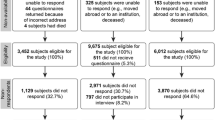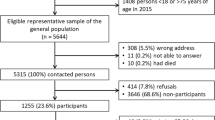Abstract
Background: Canadian normative data for the Medical Outcomes Study 36-item short form (SF-36) have recently been published. However, there is evidence from other countries to suggest that regional variation in health-related quality of life (HRQOL) may exist. We therefore examined the SF-36 data from nine Canadian centres for evidence of systematic differences.
Methods: Bayesian hierarchical modelling was used to compare the differences in the eight SF-36 domains and the two summary component scores within each of the age and gender strata across the nine sites.
Results: Five domains and the two summary component scores showed little clinically important variation. Other than a small number of exceptions, there was little overall evidence of HRQOL differences across most domains and across most sites.
Interpretation: Our finding of only a few small differences suggests that there is no need to develop region-specific Canadian normative data for the SF-36 health survey.
Résumé
Contexte: Les données normatives canadiennes s’appliquant à la version abrégée du questionnaire sur l’évolution médicale comportant 36 questions (SF-36) ont été publiées récemment. Toutefois, les données recueillies dans d’autres pays suggèrent qu’il peut exister des variations régionales au niveau de la qualité de vie reliée à l’état de santé (HRQOL). Nous avons donc étudié les données du SF-36 provenant de neuf centres canadiens pour démontrer les différences systématiques.
Méthodes: Un modèle hiérarchique bayésien a été utilisé pour comparer les différences entre les résultats des huit domaines du SF-36 et des deux composantes sommaires pour chaque strate d’âge et de sexe, et ce, pour les neuf centres.
Résultats: Les résultats de cinq domaines et des deux composantes sommaires démontraient des différences peu significatives cliniquement. Outre de rares exceptions, il y avait peu d’évidence de variations du HRQOL entre la plupart des domaines et des centres.
Interprétation: Les résultats obtenus, ne démontrant que de légères différences, suggèrent qu’il n’est pas nécessaire d’établir des données normatives spécifiques aux régions du Canada pour le questionnaire de santé SF-36.
Similar content being viewed by others
References
Ware JE. SF-36 Health Survey Manual and Interpretation Guide. Boston, Massachusetts: The Health Institute, New England Medical Centre, 1993.
Ware JE, Kosinski M, Keller SD. SF-36 Physical and Mental Health Summary Scales: A User’s Manual. Boston, Massachusetts: The Health Institute, New England Medical Centre, 1994.
Ware JE. The SF-36 Health Survey. In: Spilker B (Ed.), Quality of Life and Pharmaco-economics in Clinical Trials, Second Edition. Philadelphia: Lippincott-Raven Publishers, 1996;337–45.
Berzon RA. Understanding and using health-related quality of life instruments within clinical research studies. In: Staquet MJ, Hays RD, Fayers FM (Eds.), Quality of Life Assessment in Clinical Trials: Methods and Practice. Oxford: Oxford University Press, 1998;3–15.
Hopman WM, Towheed T, Anastassiades T, Tenenhouse A, Poliquin S, Berger C, et al. Canadian normative data for the SF-36 Health Survey. CMAJ 2000;163:265–71.
Lyons RA, Fielder H, Littlepage NC. Measuring health status with the SF-36: The need for regional norms. J Public Health Med 1995;17:46–50.
Wood-Dauphinee SW, Gauthier L, Gandek B, Magnan L, Pierre U. Readying a US measure of health status, the SF-36, for use in Canada. Clinical and Investigative Medicine 1997;20:224–38.
Wood-Dauphinee SW. The Canadian SF-36 health survey: Normative data add to its value. CMAJ 2000;163:283–84.
Kreiger N, Tenenhouse A, Joseph L, MacKenzie T, Poliquin S, Brown JP, et al. The Canadian Multicentre Osteoporosis Study (CaMos): Background, rationale, methods. Can J Aging 1999;18:376–87.
Statistics Canada provincial census data, 1991. Age, Sex and Marital Status: The Nation. Ottawa: Statistics Canada, 1993, Cat. No. 93-310.
Statistics Canada provincial census data, 1991. Profile of Census Metropolitan Areas and Census Agglomeration, Part A. Ottawa: Statistics Canada, 1993, Cat. No. 93-337.
Raftery A, Lewis S. How many iterations in the Gibbs sampler? In: Bernardo JM, Berger JO, Dawid JO, Smith AFM (Eds.), Bayesian Statistics 4. Oxford: University Press, 1992;763–73.
Spiegelhalter DJ, Thomas A, Best NG, Gilks WR. BUGS: Bayesian Inference Using Gibbs Sampling, Version 0.5, (version ii), MRC Biostatistics Unit, Cambridge, UK, 1996.
Author information
Authors and Affiliations
Consortia
Corresponding author
Additional information
Funding: The Canadian Multicentre Osteoporosis Study was funded by the Senior’s Independence Research Program, through the National Health Research and Development Program of Health Canada (Project No. 6605-4003-OS), The Medical Research Council of Canada, MRC-PMAC Health Program, Merck Frosst Canada Inc., Eli Lilly Canada Inc., Procter and Gamble Pharmaceuticals Canada Inc., Dairy Farmers of Canada
Rights and permissions
About this article
Cite this article
Hopman, W.M., Berger, C., Joseph, L. et al. Is There Regional Variation in the SF-36 Scores of Canadian Adults?. Can J Public Health 93, 233–237 (2002). https://doi.org/10.1007/BF03405008
Received:
Accepted:
Published:
Issue Date:
DOI: https://doi.org/10.1007/BF03405008




